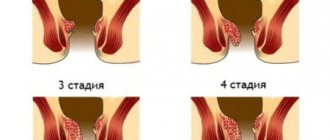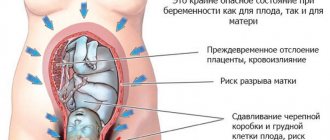Pain in the right side of the lower abdomen during pregnancy: details about the causes
During pregnancy, one of the stressful periods physically and emotionally, a woman experiences a whole range of different new feelings and sensations, unusual, painful and often unpleasant. What does this mean?
Unusual desires at the level of physical needs (for example, you really want to eat barbecue, herring, some exotic fruit, and even at night), tormenting toxicosis, severe swelling, even pinching of the sciatic nerve.
The psyche becomes labile (mobile), emotions are unstable, quickly replacing one another. This affects the appearance of certain sensations and creates internal stress for the body.
One of these special sensations occurs when the right side in the lower abdomen hurts during pregnancy, which is always worrying.
After all, with a desired pregnancy, the number one task is to bear a healthy child, and in case of a threat, to preserve it by any means necessary.
Symptoms
Pain in the right side during pregnancy will almost never act as the only external manifestation. Often this symptom is the first in the clinic, against which additional symptoms arise.
Very often, pregnant women experience aching pain, which is considered quite normal, but there are situations when the pain syndrome can increase significantly. These include:
- consumption of food, after which pain is expressed both immediately after the meal and after some time;
- excessive physical activity;
- brisk walking or running;
- sudden change in body position;
- deep breath or sharp exhalation;
- severe cough or sneezing.
Symptoms are always of a purely individual nature, which is influenced by the main provoking factor. Nevertheless, clinicians identify a number of the most common symptoms that complement the main symptom. Among them:
- increased body temperature;
- fluctuations in heart rate and blood tone;
- stool disorder;
- discomfort during urination;
- heartburn and burning behind the sternum;
- hiccups and belching;
- pallor or yellowness of the skin;
- lack of appetite;
- headaches and dizziness;
- soreness in muscles and joints;
- sleep problems;
- general malaise;
- decreased ability to work.
However, these are not all the clinical manifestations that may occur in women. The occurrence of one or more additional signs is an impetus for visiting a medical facility.
Uterine distension
It is very important to figure out what kind of pain this is in the right side, whether it threatens pregnancy or not. To do this, let’s figure out what happens to the uterus after conception.
Until a woman becomes pregnant, her uterus is small and anatomically protected by the bones of the small pelvis, “tied” to it by special ligaments.
When conception occurs, the uterus begins to grow. In the first months there is rarely localized pain.
What happens next? In the second trimester, the uterus begins to grow more and more, the fetus lies with its back either to the left or to the right. This means that the pressure inside the uterus is greater in one direction than in the other.
And the connecting threads are tenser on one side and less on the other. This is why a woman feels pain on the side where these ligaments are stretched.
It is safe for pregnant women. There is usually slight pain.
There are some signs by which you can check this:
- The only pain is in the right side of the lower abdomen. It becomes strong with any movement.
- Place your hand on your stomach. A calm uterus indicates that everything is fine. If during pain in the right side it is tense, becomes hard like a stone, then such pain becomes a sign of a threat. During pregnancy, it is especially important to “listen” to your body, all your internal sensations. If it is difficult for you to understand what is inside, it is better to go to the doctor. He will be able to give a professional assessment of the situation.
- If these pains do not occur periodically once every 15 minutes, then, as a rule, they are not associated with a threat of pregnancy.
How to behave when there is pain in the right side and it is only due to a sprained ligament? If you are sure of this, then sometimes it’s enough just to start using abdominal breathing - breathing with your stomach.
When you inhale, you “inflate” your stomach with air, and when you exhale, you “deflate” it. You get a visible effect - relaxation, calmness. If this method is not enough, then you need to lie down and relax, listen to calm music.
It is important to switch your attention from the pain in the right side to some external object, to do the desired action that brings pleasure.
So, pain in the right side of the lower abdomen is safe, provided that it is characterized by moderation, rare manifestations, and in the absence of other painful signs.
But there are other causes of pain in the right side of the lower abdomen. They have signs of sudden appearance, growth, persistent pain, do not go away in a comfortable lying position, and are accompanied by other symptoms.
Then the pain is associated with the threat of pregnancy. Let's look at these reasons.
Problems of the female sphere
In the lower right part of the female body there are such organs of the female sphere as the ovary with the appendage, part of the uterus, and the right fallopian tube.
Their violations can lead to pain in the right side of the lower abdomen during pregnancy. Let's look at these reasons.
What is the danger of pain?
Early pregnancy can be characterized by quite painful sensations in the right hypochondrium, radiating down the abdomen. Such pain can be caused by a completely normal process - fetal implantation.
Sometimes pain in the right hypochondrium can persist for several days and then intensify. In this case, pathological changes that threaten health cannot be ruled out. The most dangerous include:
- Miscarriage.
- Appendicitis.
- Ectopic pregnancy.
- Spontaneous abortion.
- Placental abruption.
- Fallopian tube rupture.
Rupture of the fallopian tube during ectopic pregnancy
It is almost impossible for a woman to diagnose an ectopic pregnancy in the early stages and prevent complex consequences on her own. After all, a noticeable deterioration in the condition occurs in the sixth week of the term. The state of health is characterized by fainting and sharp pain in the lower abdomen followed by bleeding. Ectopic pregnancy is a serious pathology that poses a threat to a woman’s life and always leads to the death of the fetus.
Note! If an ectopic pregnancy is detected long before spotting or bleeding begins, the woman may not have her fallopian tube removed.
Ectopic pregnancy
The usual name is ectopic pregnancy. At the beginning of pregnancy, nagging pains appear associated with stretching of the fallopian tube, then sharp cutting pains appear.
You can suspect an ectopic pregnancy with such pain when there is bloody vaginal discharge, slight menstruation, and the second line in the pregnancy test is not clearly colored.
If the fallopian tube ruptures, there will be acute pain in the lower right and severe bleeding. The symptoms are similar to an inflamed appendix, but there is no bleeding. Only an ambulance and surgery can save him.
You can avoid the severity of the condition if you do a transvaginal ultrasound examination at the very beginning of its appearance, when there is a tugging in the right side and pain.
It allows you to determine the presence or absence of ectopic pregnancy and avoid removal of the right tube, provided that it is diagnosed before bleeding or bloody vaginal discharge appears.
Round ligament pain
As you enter your second trimester, you may experience pain in your side, which is caused by increased stress on the ligaments that support the uterus. Typically, such pain occurs when a woman walks or gets up from a chair. With this activity, the uterus tilts and pulls on the ligament. To calm such pain, you need to lie on the side from which it appeared. Around 24 weeks of pregnancy, pain in the round ligaments disappears.
Anatomy of the ligamentous apparatus of the uterus
Ovarian cyst rupture
There are symptoms similar to ectopic pregnancy and appendicitis.
They differ in different types of pain: dull, nagging, when a cyst ruptures - acute pain, localized from the bottom right, sometimes up to loss of consciousness.
Cyst rupture is also manifested by nausea, vomiting, increased temperature and frequent urination. If a cyst is detected by ultrasound, it is usually simply observed.
If it grows, it is removed. This should not harm the pregnancy. If your right side hurts in the presence of a cyst, you can immediately assume that it has ruptured. Then you need to quickly go to the hospital.
Foodborne illnesses during pregnancy
Approximately 10% of expectant mothers develop genitourinary tract infections during pregnancy.
We suggest you read: What to do if your child’s eyes become very sour
Common symptoms include:
- sudden urge to urinate
- pain or burning during urination, and the urine may be mixed with blood.
Some patients with urinary tract infections may also experience abdominal pain. The problem with such infections during pregnancy is that they can progress to a kidney infection, which in turn can cause premature labor. This is one reason why your gynecologist asks you to take a urine test at every visit to check for bacteria that can lead to genitourinary infections. If the infection is detected early, it can be easily cured with antibiotics.
Diseases of organs not related to the female sphere
The right side is a rather loose concept, because a fairly large number of organs are located there.
Therefore, such pain is sometimes called fuzzy, since it is impossible to immediately understand which organ it is associated with.
Diseases of organs not related to the female sphere, but important from the point of view of their influence during pregnancy, constitute the next group of sources.
In the lower right part of the body there are the small and large intestines, the appendix, part of the bladder, and the ureter. When your side hurts, this may indicate inflammatory diseases of the organs.
- Inflammation of the appendix. There are cutting, dull pains concentrated in a specific point - the lower abdomen on the right. Although there are cases when pain is felt on the left, radiating to other areas of the abdominal cavity, the lower back. Any sudden movements, even coughing, increase the pain. It is accompanied by nausea, high fever, and vomiting. If the inflamed appendix is removed in time, provided that there are no other threats, the pregnancy will be saved.
- Inflammation of the genitourinary system leads to various pains appearing during pregnancy - dull, pulling, aching. This happens with cystitis. Aching pain on the right side in the lower abdomen appears when the expanding uterus pinches the ureter. Diagnosing the cause of pain will help here. To relieve inflammatory processes, it is often recommended to use chamomile infusion for douching.
- Intestinal obstruction, often called volvulus. It hurts in the stomach, abdominal cavity, right side in its lower part. The pain is acute, paroxysmal.
To understand that these are problems with the intestines, you need to know the main symptoms: impaired bowel movements, whitish coating on the tongue, dry mouth, bloating. Sometimes the gag reflex is triggered.
This disease is rare among pregnant women. But it is dangerous for the child and for the pregnant woman, and requires prompt attention to a gastroenterologist.
There is a need to separately talk about such pain as phantom (apparent). Usually, when we talk about phantom pain, we mean painful feelings where some part or organ, such as a tooth, has been removed.
But in the case of pregnancy, everything is different. In a pregnant woman, this pain is of a psychosomatic nature and is aggravated by hormonal changes.
Due to the unusual condition during pregnancy, she constantly worries and “looks” for where it hurts.
It seems to her that there is a threat to the child’s life, so she needs to exclude any pain, not to miss it, otherwise it will be too late. Some pregnant women want to attract attention to themselves, they do not have enough care.
Pain in their right side can occur quite easily. The nature of such pain is revealed during examination, when it turns out that the woman is physically healthy and there is no threat of pregnancy.
In general, when the pain is unbearable, acute and you immediately call an ambulance, you need to take the following actions:
- relax your abdominal muscles, but be sure to lie down;
- use a variant of the fetal position - lie on your right side with your legs bent to reduce the intensity of pain;
- do not use any methods of self-medication that neighbors or friends advise in friendly conversations, sharing their life experiences.
Do not under any circumstances use a warm heating pad, do not drink painkillers or herbal infusions, so as not to aggravate the condition, do not blur the picture when your side hurts.
Information about why the right side of the abdomen hurts will allow a pregnant woman or expectant mother to feel armed with knowledge and turn on the instinct of self-preservation at the right moment.
She will begin to listen and understand her body better, cope with emotions more easily and become “practical,” realizing that it is possible to prevent the development of diseases and avoid difficult situations.
Foodborne illnesses during pregnancy
It happens that abdominal pain is caused by poisoning, or rather, toxic food infections. This happens when microorganisms enter the gastrointestinal tract, causing intoxication of the body. The most likely causes of infection are dirty water, food or unwashed hands. If infection occurs, a person experiences nagging or cramping pain in the navel area, frequent loose stools, nausea, and in some cases vomiting.
* * *
As you can see, the cause of pain in the lower abdomen can be a variety of diseases, so if such symptoms occur, it is very important to seek medical help as quickly as possible. If you experience pain that you have never had to deal with before, it is better to immediately call an ambulance team.
Diagnostics
If during pregnancy a representative of the weaker half of humanity is worried about a similar symptom, then first of all you should consult an obstetrician-gynecologist and gastroenterologist. This necessity lies in the fact that often the sources of such manifestations are precisely diseases of the gastrointestinal tract.
However, based on a wide variety of provoking factors, specialists from various fields of medicine should participate in the process of establishing the correct diagnosis, for example:
- endocrinology and pulmonology;
- nephrology and vertebrology;
- neurology or oncology;
- general therapy;
- cardiology and traumatology.
The search for the primary source should always have an integrated approach, which is why the first step in diagnosis is aimed at ensuring that the physician personally carries out several manipulations. It follows that primary diagnosis may include:
- studying the medical history to determine the most likely provoking factor;
- familiarization and analysis of life history to confirm the influence of physiological causes;
- gynecological examination;
- a thorough physical examination;
- measuring body temperature and pulse, heart rate and blood tone;
- study of the condition of the skin and mucous membranes;
- a detailed survey of the patient to obtain detailed information from the doctor regarding the symptoms.
After this, the following laboratory tests are indicated:
- general clinical analysis of blood and urine;
- blood biochemistry;
- coprogram;
- serological and PCR tests;
- hormonal and immunological studies.
As for instrumental examination, in this case it is limited to ultrasound, CT and MRI - these are the procedures that are allowed for women during pregnancy.
Ultrasound of the abdominal cavity during pregnancy
Встречи с ними запоминаются на всю жизнь, феи проститутки Новосибирск по вызову, отдых для респектабельных мужчин - feinsk.org. Просто заказать для себя проститутку и провести с ней самую лучшую ночь в жизни. Милые феи проститутки Новосибирск по вызову, горячие и прелестные, они такие активные и чуткие, что у тебя будет сегодня классный секс. Не отказывай себе в удовольствии.









